人教版七年级下册Unit4 Don't eat in class.SectionA 第二课时(共38张PPT)
文档属性
| 名称 | 人教版七年级下册Unit4 Don't eat in class.SectionA 第二课时(共38张PPT) | 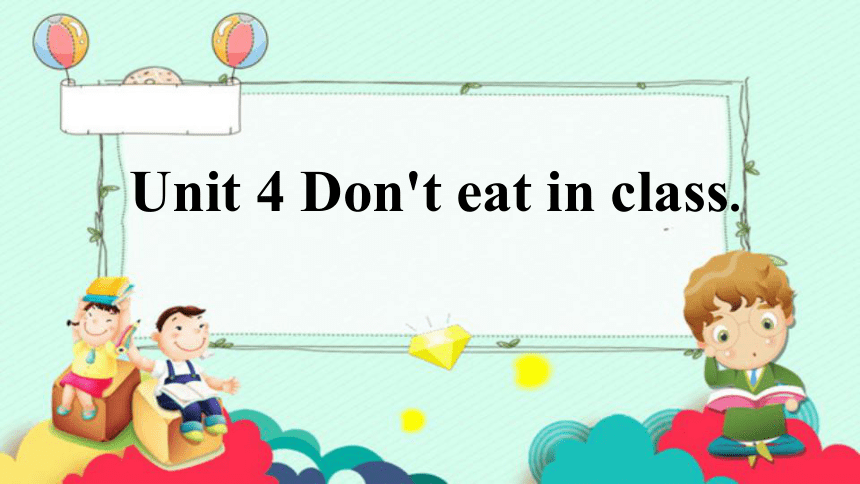 | |
| 格式 | zip | ||
| 文件大小 | 1.4MB | ||
| 资源类型 | 教案 | ||
| 版本资源 | 人教新目标(Go for it)版 | ||
| 科目 | 英语 | ||
| 更新时间 | 2020-03-12 21:27:30 | ||
图片预览

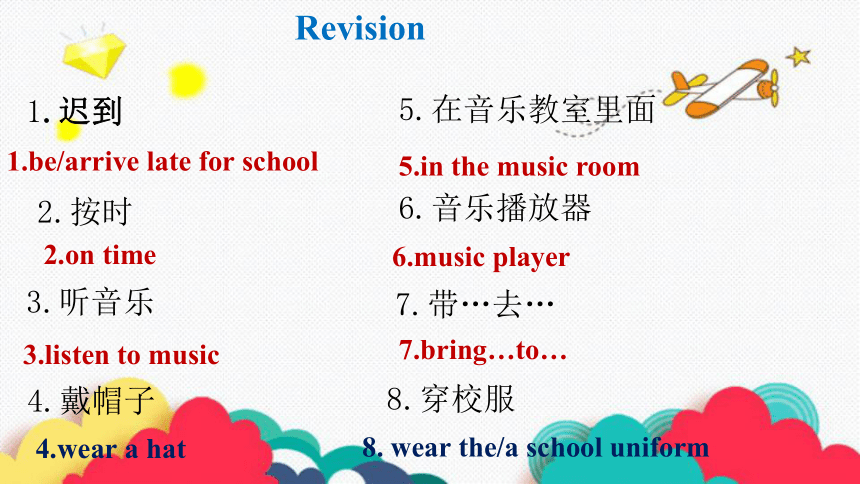
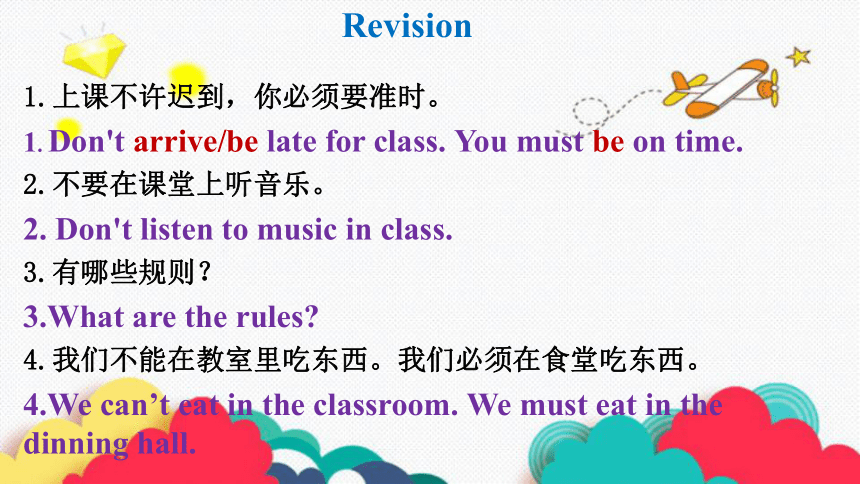
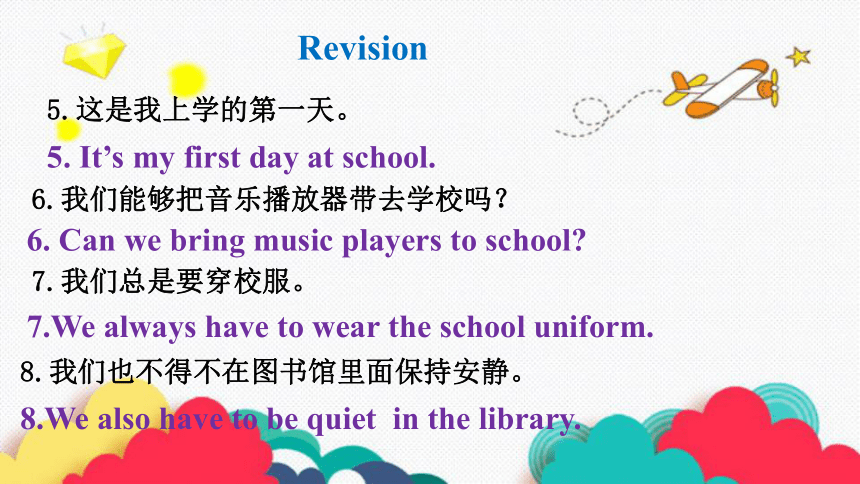
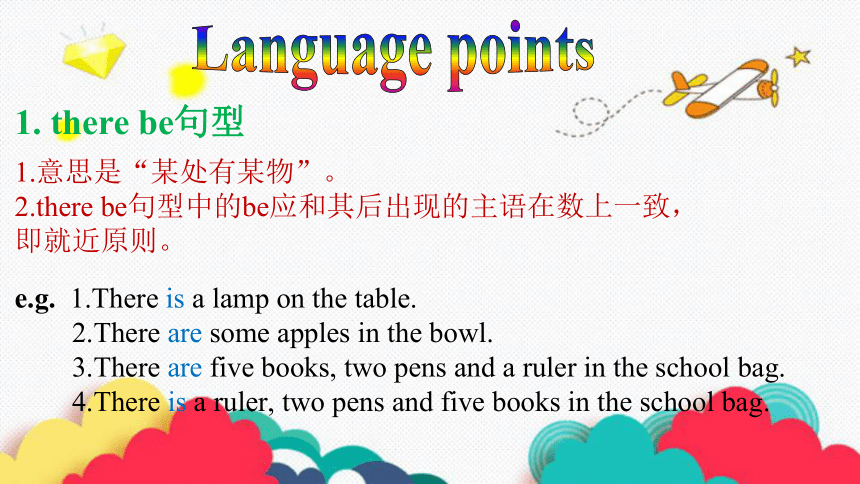
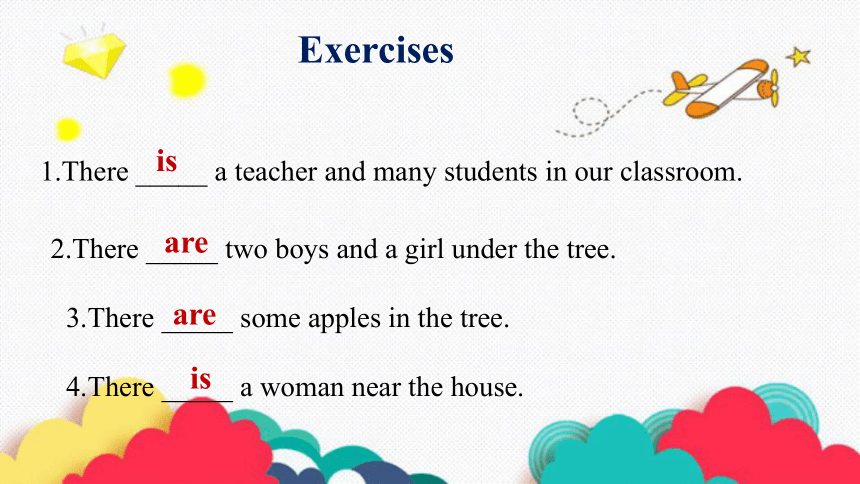
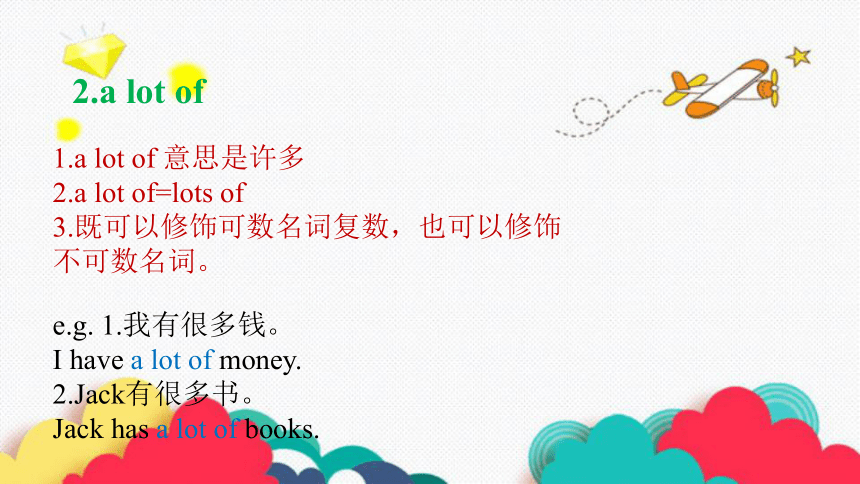
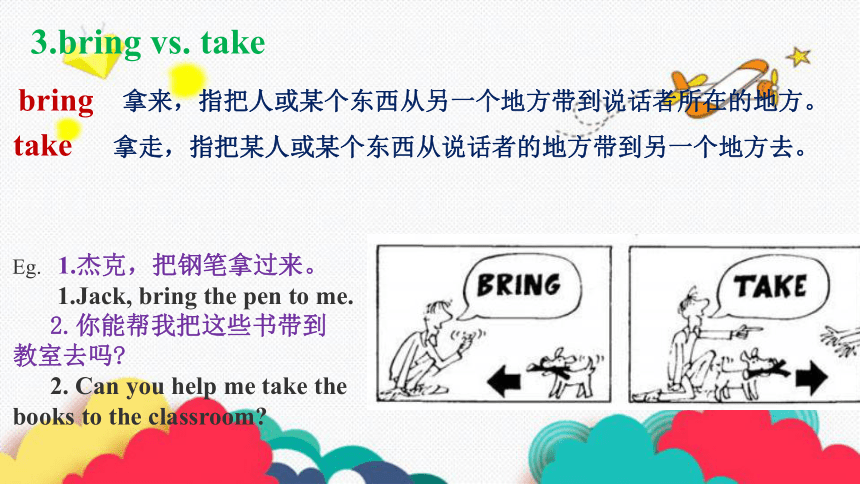
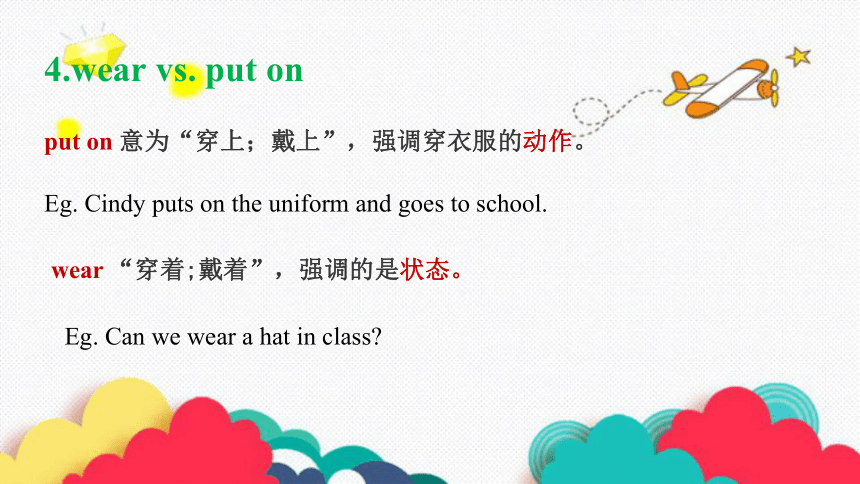
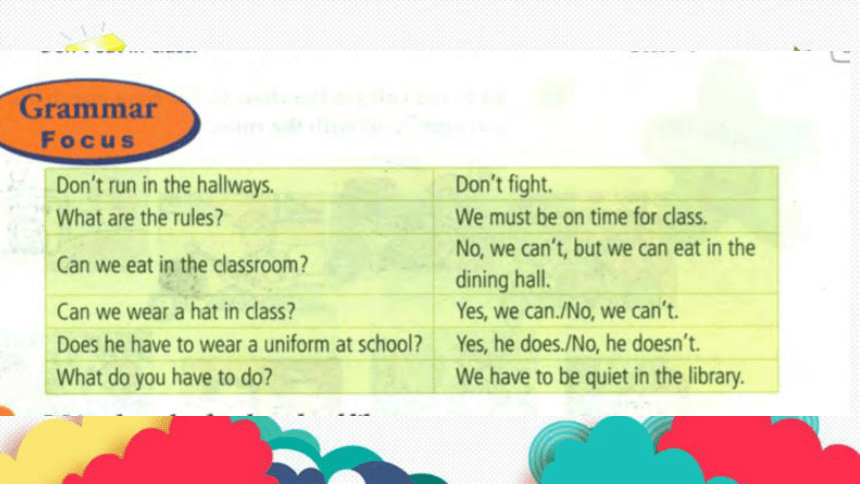
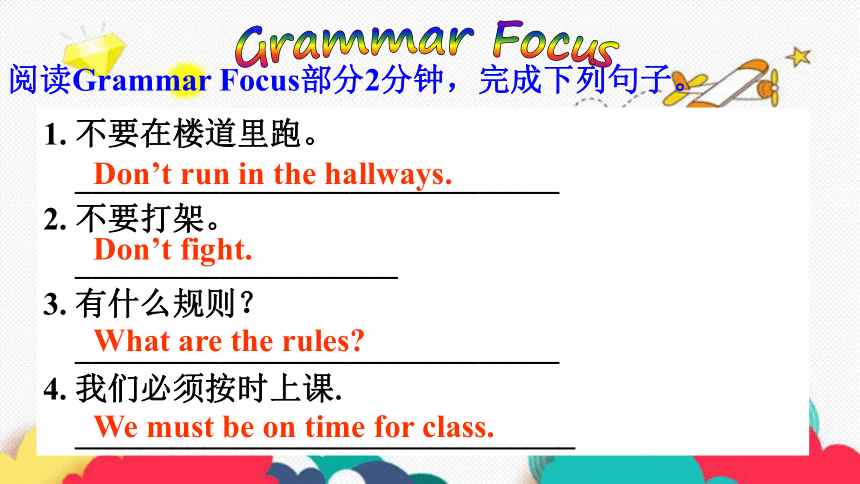
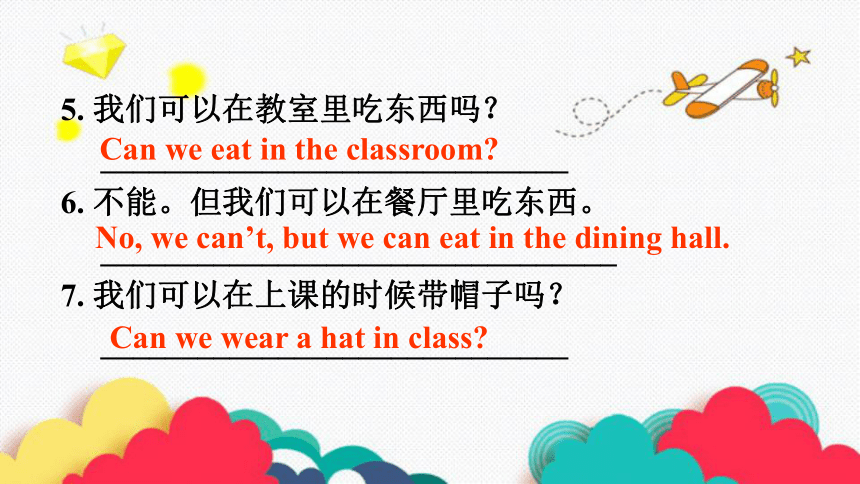
文档简介
(共38张PPT)
Unit 4 Don't eat in class.
Revision
1.迟到
1.be/arrive late for school
2.按时
2.on time
3.听音乐
3.listen to music
4.戴帽子
4.wear a hat
5.在音乐教室里面
5.in the music room
6.音乐播放器
6.music player
7.带…去…
7.bring…to…
8.穿校服
8. wear the/a school uniform
1.上课不许迟到,你必须要准时。
1. Don't arrive/be late for class. You must be on time.
2.不要在课堂上听音乐。
2. Don't listen to music in class.
3.有哪些规则?
3.What are the rules?
4.我们不能在教室里吃东西。我们必须在食堂吃东西。
4.We can’t eat in the classroom. We must eat in the dinning hall.
Revision
Revision
5.这是我上学的第一天。
5. It’s my first day at school.
6.我们能够把音乐播放器带去学校吗?
6. Can we bring music players to school?
7.我们总是要穿校服。
7.We always have to wear the school uniform.
8.我们也不得不在图书馆里面保持安静。
8.We also have to be quiet in the library.
Language points
1. there be句型
1.意思是“某处有某物”。
2.there be句型中的be应和其后出现的主语在数上一致,即就近原则。
e.g. 1.There is a lamp on the table.
2.There are some apples in the bowl.
3.There are five books, two pens and a ruler in the school bag.
4.There is a ruler, two pens and five books in the school bag.
Exercises
1.There _____ a teacher and many students in our classroom.
2.There _____ two boys and a girl under the tree.
3.There _____ some apples in the tree.
4.There _____ a woman near the house.
is
are
are
is
2.a lot of
1.a lot of 意思是许多
2.a lot of=lots of
3.既可以修饰可数名词复数,也可以修饰不可数名词。
e.g. 1.我有很多钱。
I have a lot of money.
2.Jack有很多书。
Jack has a lot of books.
3.bring vs. take
bring
take
拿走,指把某人或某个东西从说话者的地方带到另一个地方去。
拿来,指把人或某个东西从另一个地方带到说话者所在的地方。
Eg. 1.杰克,把钢笔拿过来。
1.Jack, bring the pen to me.
2.你能帮我把这些书带到教室去吗?
2. Can you help me take the books to the classroom?
4.wear vs. put on
put on 意为“穿上;戴上”,强调穿衣服的动作。
Eg. Cindy puts on the uniform and goes to school.
wear “穿着;戴着”,强调的是状态。
Eg. Can we wear a hat in class?
1. 不要在楼道里跑。
______________________________
2. 不要打架。
____________________
3. 有什么规则?
______________________________
4. 我们必须按时上课.
_______________________________
阅读Grammar Focus部分2分钟,完成下列句子。
Don’t fight.
Don’t run in the hallways.
What are the rules?
We must be on time for class.
Grammar Focus
5. 我们可以在教室里吃东西吗?
_____________________________
6. 不能。但我们可以在餐厅里吃东西。
________________________________
7. 我们可以在上课的时候带帽子吗?
_____________________________
Can we wear a hat in class?
No, we can’t, but we can eat in the dining hall.
Can we eat in the classroom?
8. 他在学校里必须穿校服吗?
__________________________________
9. 是的,必须。/ 不,不必。
_______________________________
10. 你们必须做什么?
_______________________________
11. 在图书馆里我们必须保持安静。
_________________________________
Yes, he does. / No, he doesn’t.
Does he have to wear a uniform at school?
What do you have to do?
We have to be quiet in the library.
祈使句
1.祈使句是表示命令、叮嘱、号召等的句子;
2.通常省略主语you;
3.句中谓语动词用动词原形;
4.祈使句有肯定和否定两种。
2. 句子结构
(1) 肯定句:__________+ 其他
在餐厅里吃东西。
________________________________
在音乐教室里听音乐。
________________________________
骑自行车去上学。
_________________________________
Ride the bike to school.
Eat in the dining hall.
动词原形
Listen to music in the music room.
请准时。
_________________________________
Be on time, please.
(2) 否定句: _____ + _________+ 其他
不要和同学们打架。
_______________________________
不要在教室里打篮球。
________________________________
Don’t fight with your classmates.
Don’t play basketball in the classroom.
Don’t 动词原形
________________________________
上课不要迟到。
Don’t be/arrive late for class.
以let开头的祈使句 结构:____+ sb.(宾格)+动词原形
Let
Let’s walk to school.
让Mike写作业吧。
_________________
Let Mike do his homework.
_________________
让我们步行去上学吧。
No + 动词ing形式/名词。
禁止停车!
Don’t park.
Don’t smoke.
Don’t take photos.
表示“禁止、规劝”,常用于警示语或标语牌。
No Parking.
No Smoking.
No Photos.
禁止吸烟!
禁止拍照!
二、询问和讨论学校规则:
1. ━有什么规则?
━我们必须保持安静。
__________________
_____________________
2. ━我们可以在上课的时候戴帽子吗?
________________________________
━不可以。你可以在外面戴帽子。
___________ ______________________
What are the rules?
We must be quiet.
Can we wear a hat in class?
No, we can’t. You can wear a hat outside.
3. ━你必须做什么事?
_______________________
━我们必须穿校服。
________________________________
4. 他必须在校吃午饭吗?
__________________________________
We must wear the school uniforms.
What do you have to do?
Does he have to eat lunch at school?
have to(不得不)的用法
1. have to句式
肯定式: 主语+have/has to + 动词原形
We have to leave now.
She has to work on Sunday.
否定式: 主语+don’t/doesn’t have to + 动词原形
You don’t have to walk so fast.
He doesn’t have to buy a new coat.
特殊疑问句:疑问词+do/does+主语+have to+动词原形+…?
What do you have to do now?
Where does she have to go?
一般疑问式:
Do/Does+主语+have to+动词原形+…?
--Do you have to study English now?
--Yes, I do.
--Does he have to go now?
–No, he doesn’t (have to).
2.have to 与must的区别
(1)have to 着重于客观的需要,含有不得不的客观强制性;
must着重于主观上自己认为有义务,有必要。
She has to clean the classroom every week.
I must go now.
(2)在否定句中,don’t have to 表示没有必要,
must not表示不允许,严禁。
You don’t have to go there.
You mustn’t play football on the road.
(3)must一般只表示现在,没有人称和数的变化。
have to可以用于不同的时态,有人称和数的变化。
I/We/You/They must work hard.
I have to finish my work today.
She has to finish her work today.
They had to get to the station before 5:00.
1.﹣Why can't Nancy come to your party?
﹣Because she ________do her homework.( )
A.can B.can't
C.has to D.doesn't have to
2.______ play computer games after school.( )
A.Can’t B.No C.Not D.Don't
C
D
can
1.can是情态动词,没有人称和数的变化。
2.can本身词义不完全,不能单独使用,后面要加实义动词。
1)can表能力。
He can speak French.
I can play the piano.
2)can表许可。
You can play basketball on weekends.
We can’t run in the hallways.
Library Rules
Don’t talk.
__________________
__________________
__________________
3a Write the rules for the
school library.
Writing
Don’t listen to music.
Don’t eat or drink.
Don’t take photos.
方法指导:
1. 由图示可知都是一些禁止类的祈使句。
2. 可知应用“Don’t + 动词原形” 或“No+动词ing/名词” 的句子。
Library Rules
1.No talking!
2. No food!
3.No listening to music!
4.No photos!
Be quiet? (she/have to /in the library)
Q: Does she have to be quiet in the library?
A: Yes, she does.
3b Use the words to make questions
about the rules. Then write
answers according to your school.
Writing
2. Eat? (he/have to/in the dinning hall)
Q: __________________________
A: __________________________
Listen to music? (we/can/in the hallways)
Q: __________________________
A: __________________________
4. Wear a hat? (we/can/in the classroom)
Q: ________________________
A: ________________________
1. 根据例句,可知要求我们造一般疑问句并根据实际情况进行回答。
2. 先确定句子的主语。
3. 再确定用情态动词还是用助动词来构成疑问语序。
4. 根据实际情况做出肯定或否定回答,答语的主语要与问句保持一致。
方法指导
2. Eat? (he/have to/in the dining hall)
Q: ________________________________?
A: _____________
3. Listen to music? (we/can/in the hallways)
Q: ________________________________?
A: _____________
4. Wear a hat? (we/can/in the classroom)
Q: _____________________________?
A: ____________
Then answer the questions.
Yes, he does.
Does he have to eat in the dining hall
Can we listen to music in the hallways
No, we can’t.
Can we wear a hat in the classroom
No, we can’t.
At my dream school, we don’t have to come to school every day. …
We can eat in class. …
3c Make up five cool rules for your
dream school. Share your rules with
the class. Your classmates vote for
the Coolest School!
Discussion
哪些情况下要用动词原形?
Unit 4 Don't eat in class.
Revision
1.迟到
1.be/arrive late for school
2.按时
2.on time
3.听音乐
3.listen to music
4.戴帽子
4.wear a hat
5.在音乐教室里面
5.in the music room
6.音乐播放器
6.music player
7.带…去…
7.bring…to…
8.穿校服
8. wear the/a school uniform
1.上课不许迟到,你必须要准时。
1. Don't arrive/be late for class. You must be on time.
2.不要在课堂上听音乐。
2. Don't listen to music in class.
3.有哪些规则?
3.What are the rules?
4.我们不能在教室里吃东西。我们必须在食堂吃东西。
4.We can’t eat in the classroom. We must eat in the dinning hall.
Revision
Revision
5.这是我上学的第一天。
5. It’s my first day at school.
6.我们能够把音乐播放器带去学校吗?
6. Can we bring music players to school?
7.我们总是要穿校服。
7.We always have to wear the school uniform.
8.我们也不得不在图书馆里面保持安静。
8.We also have to be quiet in the library.
Language points
1. there be句型
1.意思是“某处有某物”。
2.there be句型中的be应和其后出现的主语在数上一致,即就近原则。
e.g. 1.There is a lamp on the table.
2.There are some apples in the bowl.
3.There are five books, two pens and a ruler in the school bag.
4.There is a ruler, two pens and five books in the school bag.
Exercises
1.There _____ a teacher and many students in our classroom.
2.There _____ two boys and a girl under the tree.
3.There _____ some apples in the tree.
4.There _____ a woman near the house.
is
are
are
is
2.a lot of
1.a lot of 意思是许多
2.a lot of=lots of
3.既可以修饰可数名词复数,也可以修饰不可数名词。
e.g. 1.我有很多钱。
I have a lot of money.
2.Jack有很多书。
Jack has a lot of books.
3.bring vs. take
bring
take
拿走,指把某人或某个东西从说话者的地方带到另一个地方去。
拿来,指把人或某个东西从另一个地方带到说话者所在的地方。
Eg. 1.杰克,把钢笔拿过来。
1.Jack, bring the pen to me.
2.你能帮我把这些书带到教室去吗?
2. Can you help me take the books to the classroom?
4.wear vs. put on
put on 意为“穿上;戴上”,强调穿衣服的动作。
Eg. Cindy puts on the uniform and goes to school.
wear “穿着;戴着”,强调的是状态。
Eg. Can we wear a hat in class?
1. 不要在楼道里跑。
______________________________
2. 不要打架。
____________________
3. 有什么规则?
______________________________
4. 我们必须按时上课.
_______________________________
阅读Grammar Focus部分2分钟,完成下列句子。
Don’t fight.
Don’t run in the hallways.
What are the rules?
We must be on time for class.
Grammar Focus
5. 我们可以在教室里吃东西吗?
_____________________________
6. 不能。但我们可以在餐厅里吃东西。
________________________________
7. 我们可以在上课的时候带帽子吗?
_____________________________
Can we wear a hat in class?
No, we can’t, but we can eat in the dining hall.
Can we eat in the classroom?
8. 他在学校里必须穿校服吗?
__________________________________
9. 是的,必须。/ 不,不必。
_______________________________
10. 你们必须做什么?
_______________________________
11. 在图书馆里我们必须保持安静。
_________________________________
Yes, he does. / No, he doesn’t.
Does he have to wear a uniform at school?
What do you have to do?
We have to be quiet in the library.
祈使句
1.祈使句是表示命令、叮嘱、号召等的句子;
2.通常省略主语you;
3.句中谓语动词用动词原形;
4.祈使句有肯定和否定两种。
2. 句子结构
(1) 肯定句:__________+ 其他
在餐厅里吃东西。
________________________________
在音乐教室里听音乐。
________________________________
骑自行车去上学。
_________________________________
Ride the bike to school.
Eat in the dining hall.
动词原形
Listen to music in the music room.
请准时。
_________________________________
Be on time, please.
(2) 否定句: _____ + _________+ 其他
不要和同学们打架。
_______________________________
不要在教室里打篮球。
________________________________
Don’t fight with your classmates.
Don’t play basketball in the classroom.
Don’t 动词原形
________________________________
上课不要迟到。
Don’t be/arrive late for class.
以let开头的祈使句 结构:____+ sb.(宾格)+动词原形
Let
Let’s walk to school.
让Mike写作业吧。
_________________
Let Mike do his homework.
_________________
让我们步行去上学吧。
No + 动词ing形式/名词。
禁止停车!
Don’t park.
Don’t smoke.
Don’t take photos.
表示“禁止、规劝”,常用于警示语或标语牌。
No Parking.
No Smoking.
No Photos.
禁止吸烟!
禁止拍照!
二、询问和讨论学校规则:
1. ━有什么规则?
━我们必须保持安静。
__________________
_____________________
2. ━我们可以在上课的时候戴帽子吗?
________________________________
━不可以。你可以在外面戴帽子。
___________ ______________________
What are the rules?
We must be quiet.
Can we wear a hat in class?
No, we can’t. You can wear a hat outside.
3. ━你必须做什么事?
_______________________
━我们必须穿校服。
________________________________
4. 他必须在校吃午饭吗?
__________________________________
We must wear the school uniforms.
What do you have to do?
Does he have to eat lunch at school?
have to(不得不)的用法
1. have to句式
肯定式: 主语+have/has to + 动词原形
We have to leave now.
She has to work on Sunday.
否定式: 主语+don’t/doesn’t have to + 动词原形
You don’t have to walk so fast.
He doesn’t have to buy a new coat.
特殊疑问句:疑问词+do/does+主语+have to+动词原形+…?
What do you have to do now?
Where does she have to go?
一般疑问式:
Do/Does+主语+have to+动词原形+…?
--Do you have to study English now?
--Yes, I do.
--Does he have to go now?
–No, he doesn’t (have to).
2.have to 与must的区别
(1)have to 着重于客观的需要,含有不得不的客观强制性;
must着重于主观上自己认为有义务,有必要。
She has to clean the classroom every week.
I must go now.
(2)在否定句中,don’t have to 表示没有必要,
must not表示不允许,严禁。
You don’t have to go there.
You mustn’t play football on the road.
(3)must一般只表示现在,没有人称和数的变化。
have to可以用于不同的时态,有人称和数的变化。
I/We/You/They must work hard.
I have to finish my work today.
She has to finish her work today.
They had to get to the station before 5:00.
1.﹣Why can't Nancy come to your party?
﹣Because she ________do her homework.( )
A.can B.can't
C.has to D.doesn't have to
2.______ play computer games after school.( )
A.Can’t B.No C.Not D.Don't
C
D
can
1.can是情态动词,没有人称和数的变化。
2.can本身词义不完全,不能单独使用,后面要加实义动词。
1)can表能力。
He can speak French.
I can play the piano.
2)can表许可。
You can play basketball on weekends.
We can’t run in the hallways.
Library Rules
Don’t talk.
__________________
__________________
__________________
3a Write the rules for the
school library.
Writing
Don’t listen to music.
Don’t eat or drink.
Don’t take photos.
方法指导:
1. 由图示可知都是一些禁止类的祈使句。
2. 可知应用“Don’t + 动词原形” 或“No+动词ing/名词” 的句子。
Library Rules
1.No talking!
2. No food!
3.No listening to music!
4.No photos!
Be quiet? (she/have to /in the library)
Q: Does she have to be quiet in the library?
A: Yes, she does.
3b Use the words to make questions
about the rules. Then write
answers according to your school.
Writing
2. Eat? (he/have to/in the dinning hall)
Q: __________________________
A: __________________________
Listen to music? (we/can/in the hallways)
Q: __________________________
A: __________________________
4. Wear a hat? (we/can/in the classroom)
Q: ________________________
A: ________________________
1. 根据例句,可知要求我们造一般疑问句并根据实际情况进行回答。
2. 先确定句子的主语。
3. 再确定用情态动词还是用助动词来构成疑问语序。
4. 根据实际情况做出肯定或否定回答,答语的主语要与问句保持一致。
方法指导
2. Eat? (he/have to/in the dining hall)
Q: ________________________________?
A: _____________
3. Listen to music? (we/can/in the hallways)
Q: ________________________________?
A: _____________
4. Wear a hat? (we/can/in the classroom)
Q: _____________________________?
A: ____________
Then answer the questions.
Yes, he does.
Does he have to eat in the dining hall
Can we listen to music in the hallways
No, we can’t.
Can we wear a hat in the classroom
No, we can’t.
At my dream school, we don’t have to come to school every day. …
We can eat in class. …
3c Make up five cool rules for your
dream school. Share your rules with
the class. Your classmates vote for
the Coolest School!
Discussion
哪些情况下要用动词原形?
同课章节目录
- Unit 1 Can you play the guitar?
- Section A
- Section B
- Unit 2 What time do you go to school?
- Section A
- Section B
- Unit 3 How do you get to school?
- Section A
- Section B
- Unit 4 Don't eat in class.
- Section A
- Section B
- Unit 5 Why do you like pandas?
- Section A
- Section B
- Unit 6 I'm watching TV.
- Section A
- Section B
- Review of Units 1-6
- Unit 7 It's raining!
- Section A
- Section B
- Unit 8 Is there a post office near here?
- Section A
- Section B
- Unit 9 What does he look like?
- Section A
- Section B
- Unit 10 I'd like some noodles.
- Section A
- Section B
- Unit 11 How was your school trip?
- Section A
- Section B
- Unit 12 What did you do last weekend?
- Section A
- Section B
